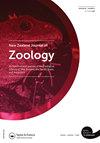从新西兰和土耳其采集的鱼鳞的形态计量学
IF 1.1
4区 生物学
Q3 ZOOLOGY
引用次数: 0
摘要
摘要本研究调查了四个鱼类科的十一种鱼类的鳞片形状,以推断是否可以通过鳞片形状来确定鱼类的科、种和地理起源。由于该科的五个物种中有三个发生在新西兰,两个发生在土耳其,因此仅对鲤鱼科进行了位点分化分析。之所以使用形态计量分析,是因为它允许进行标准的多变量分析,同时保留有关尺度形状的信息。采用广义Procrustes分析法对尺度形状数据进行分析。将主成分得分提交给典型判别分析,以确定按科、物种和地理变异进行判别的有效性。MANOVA评估了分类的重要性。MANOVA在地理位置以及科和物种的尺度形状上都存在差异。科、种和地理变异分别解释了91.7%、82.4%和95.8%的变异。土耳其标本和新西兰标本对每个地理位置的正确分类率分别为92.9%和98.4%。鱼鳞形状在区分物种和远亲成员方面效果较差,但在鱼类家族之间进行区分时效果更好,在同一家族但不同体型的鱼鳞之间效果最好。本文章由计算机程序翻译,如有差异,请以英文原文为准。
The morphometry of fish scales collected from New Zealand and Turkey
ABSTRACT This study examines the shape of scales from eleven fish species belonging to four fish families to infer whether the family, species and the geographic origin of fishes could be determined using scale shape. Site differentiation was analyzed only for the Cyprinidae since from the five species of this family three occurred in New Zealand and two in Turkey. Morphometric analysis was used because it allows standard multivariate analyses while preserving information about scale shape. Generalized Procrustes Analysis was used to analyse the data on scale shape. Principal components scores were submitted to canonical discriminant analysis to determine the efficacy of discrimination by families, species and geographic variants. The significance of classifications was assessed by MANOVA. MANOVA showed differences in the scale shape for the geographic location as well as by families and species. Families, species and geographic variants explained 91.7%, 82.4% and 95.8%, of the variation respectively. Each geographic location was correctly classified in 92.9% for Turkish and 98.4% New Zealand specimens. Fish scale shape was less effective in discriminating species from distantly related members, but better when the discrimination was among fish families, and best between fish scales for the same family but different body shapes.
求助全文
通过发布文献求助,成功后即可免费获取论文全文。
去求助
来源期刊
CiteScore
2.80
自引率
0.00%
发文量
20
审稿时长
>12 weeks
期刊介绍:
Aims: The diversity of the fauna of the southern continents and oceans is of worldwide interest to researchers in universities, museums, and other centres. The New Zealand Journal of Zoology plays an important role in disseminating information on field-based, experimental, and theoretical research on the zoology of the region.

 求助内容:
求助内容: 应助结果提醒方式:
应助结果提醒方式:


